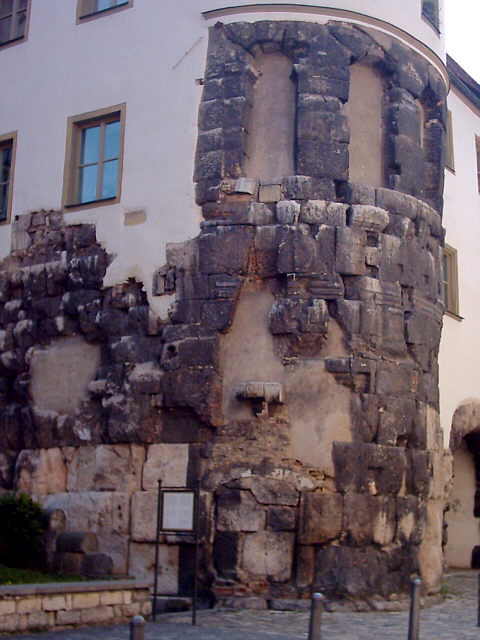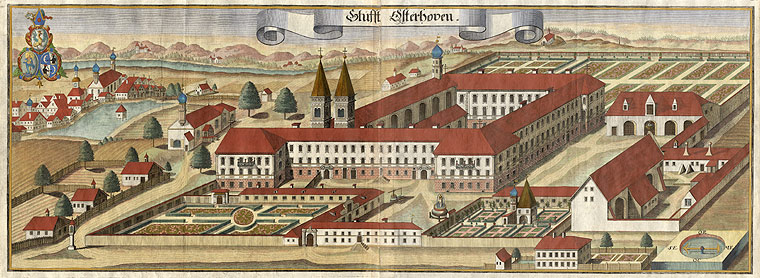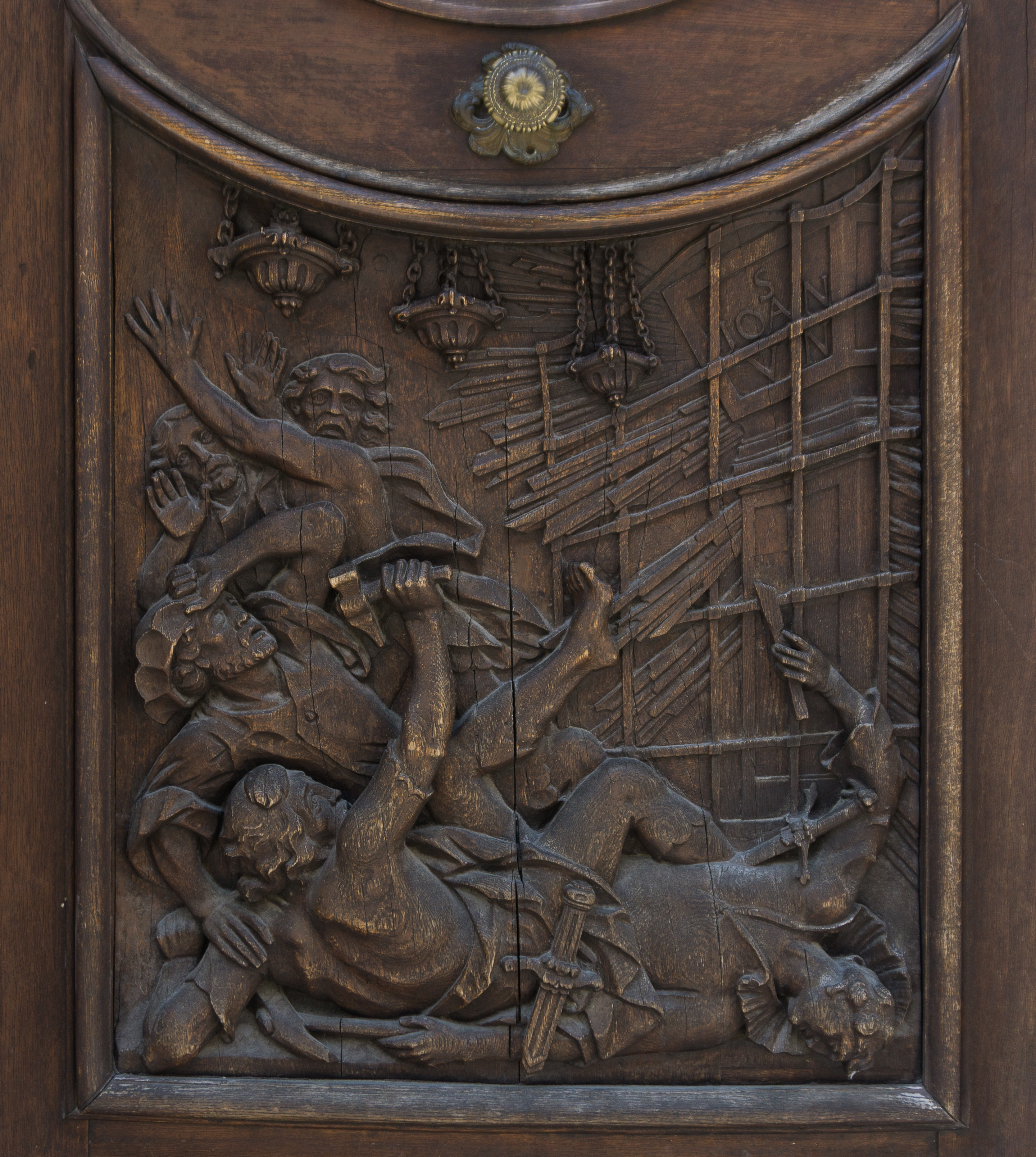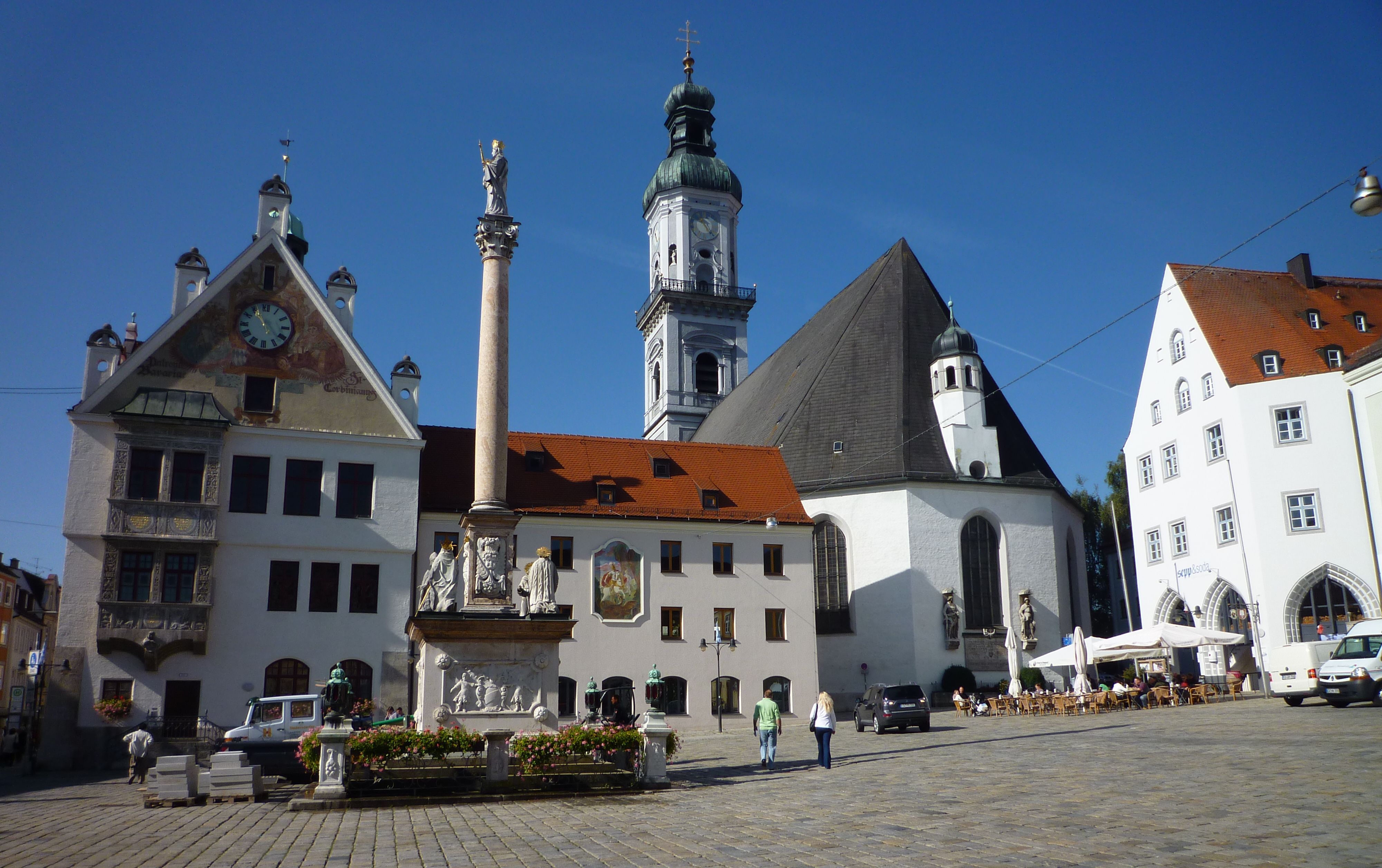|
Egid Quirin Asam
Egid Quirin Asam (1 September 1692 – 29 April 1750) was a German plasterer, sculptor, architect, and painter. He was active during the Late Baroque and Rococo periods. Born in Tegernsee, Bavaria, Asam worked mainly together with his brother, the architect and painter Cosmas Damian Asam. Because of this, their common work is often attributed to the Asam Brothers. Asam died in Mannheim, Baden-Württemberg. Biography Egid Quirin Asam was born on 1 September 1692, in Tegernsee, Bavaria, and baptised the same day.Hitchcock (1968), p. 232. His father was Hans Georg Asam (1649–1741) and his mother was Maria Theresia Asam. Among his eight siblings were Cosmas Damian Asam and Maria Salome Asam. Major works The Asam Brothers, singularly and together, were very prolific artists. Some of their major works were: Bavaria * Aldersbach— Monastery Church of Mariae Himmelfahrt (stucco of swirling garlands and capitals and pillars in the Italian Baroque tradition) * Benediktb ... [...More Info...] [...Related Items...] OR: [Wikipedia] [Google] [Baidu] |
Tegernsee
Tegernsee () is a Town#Germany, town in the Miesbach (district), Miesbach district of Bavaria, Germany. It is located on the banks of Tegernsee (lake), Lake Tegernsee, which is 747 m (2,451 ft) AMSL, above sea level. A spa town, it is surrounded by an alpine landscape of Upper Bavaria, and has an economy mainly based on Tourism in Germany, tourism. The town is home to a former Benedictine monastery, the Tegernsee Abbey. Today the building is a ''Schloss''. The northern wing of the abbey contains a brewery that produces the famous Tegernsee Lager Beer. History The original settlers of the area around the lake are not known. The recorded history of the region and of the town began with the arrival of the Bavarians in the sixth century AD. The noble family of the Agilolfings ruled this region and the entire Duchy of Bavaria. In 746, the brothers Adalbert and Ottokar, of the noble family of Huosi, founded a Benedictine monastery, Tegernsee Abbey. Its name derives from O ... [...More Info...] [...Related Items...] OR: [Wikipedia] [Google] [Baidu] |
Benediktbeuern
Benediktbeuern (; Central Bavarian: ''Benediktbeiern'') is a municipality in the district of Bad Tölz-Wolfratshausen in Bavaria, Germany, 2 kilometers, or 1.25 miles from Bichl. The village has 3,602 residents as of 31 December 2019. The medieval Latin name of Benediktbeuern was ''Buria'' (adjective: ''Burana'').SeOrbis Latinus/ref> Benediktbeuern has a famous monastery, formerly belonging to the Benedictine Order, called Benediktbeuern Abbey, which was founded in about 739. Its name is well known because of the '' Carmina Burana'' ('Benediktbeuern songs') manuscript found there in 1803 and subsequently set to music by Carl Orff. Since 1930 the Salesians of Don Bosco have lived in this monastery. Johann Wolfgang von Goethe visited Benediktbeuern during his third journey to Italy in 1786. The secular village itself - its ribbon-development clearly distinct from the abbey's edifices - was called Laingruben until 30 November 1865, when it was permitted to take the name of the m ... [...More Info...] [...Related Items...] OR: [Wikipedia] [Google] [Baidu] |
Regensburg
Regensburg (historically known in English as Ratisbon) is a city in eastern Bavaria, at the confluence of the rivers Danube, Naab and Regen (river), Regen, Danube's northernmost point. It is the capital of the Upper Palatinate subregion of the state. With more than 150,000 inhabitants, Regensburg is the List of cities in Bavaria by population, fourth-largest city in the State of Bavaria after Munich, Nuremberg and Augsburg and the eighth-largest of all List of cities and towns on the river Danube, cities on the river Danube. From its foundation as an imperial Roman river fort, the city has been the political, economic and cultural centre of the surrounding region. Later, under the rule of the Holy Roman Empire, it housed the Perpetual Diet of Regensburg. The medieval centre of the city was made a UNESCO World Heritage Site in 2006 because of its well-preserved architecture, being the biggest medieval city site north of the Alps, and the city's historical importance for assembli ... [...More Info...] [...Related Items...] OR: [Wikipedia] [Google] [Baidu] |
Osterhofen Abbey
Osterhofen Abbey (, also called Altenmarkt Convent ) is a former monastery in Bavaria, Germany, It is located in the Altenmarkt section of Osterhofen, a town to the south of the Danube between Deggendorf and Vilshofen / Passau. It has its origins in a collegiate built in 1004–09. From 1128 to 1783 it was a Premonstratensian monastery. For a while it was then a convent. Today it contains a girls' secondary school. The former abbey church, a magnificent late baroque building erected in 1726–40, is now the Basilica of Saint Margaret. Monastery history Henry V, Duke of Bavaria and his wife Luitgard erected a collegiate abbey of Augustinian Canons in his palace in Osterhofen in 1004–09. In 1017 the Emperor Henry II of Germany transferred the abbey to the diocese of Bamberg. In 1128 Bishop Otto of Bamberg brought men and women from the Premonstratensian Ursberg Abbey to the Osterhofen collegiate abbey. The abbey was endowed with extensive properties in the Wachau valley of Aus ... [...More Info...] [...Related Items...] OR: [Wikipedia] [Google] [Baidu] |
Asamkirche (München)
St. Johann Nepomuk, better known as the Asam Church (German: ), is a Baroque church in Munich, southern Germany. It was built from 1733 to 1746 by a pair of brothers, sculptor Egid Quirin Asam and painter Cosmas Damian Asam, as their private church. It is considered to be one of the most important buildings of the southern German Late Baroque. Architecture The church was not commissioned, but built as a private chapel for the greater glory of God and the salvation of the builders. This also allowed the Asam brothers to build in line with their ideas as independent contractors. For example, Egid Quirin Asam could see the altar through a window of his private house next to the church (Asamhaus). He also designed the church as a ''Beichtkirche'' (confession church) for the youth. The small church therefore has seven confessionals with allegorical scenes. The Baroque façade is integrated into the houses of the Sendlingerstraße and swings slightly convex outward. St. Johann Nep ... [...More Info...] [...Related Items...] OR: [Wikipedia] [Google] [Baidu] |
Abbey Church Of St
An abbey is a type of monastery used by members of a religious order under the governance of an abbot or abbess. Abbeys provide a complex of buildings and land for religious activities, work, and housing of Christian monks and nuns. The concept of the abbey has developed over many centuries from the early monastic ways of religious men and women where they would live isolated from the lay community about them. Religious life in an abbey may be monastic. An abbey may be the home of an enclosed religious order or may be open to visitors. The layout of the church and associated buildings of an abbey often follows a set plan determined by the founding religious order. Abbeys are often self-sufficient while using any abundance of produce or skill to provide care to the poor and needy, refuge to the persecuted, or education to the young. Some abbeys offer accommodation to people who are seeking spiritual retreat. There are many famous abbeys across the Mediterranean Basin and Eur ... [...More Info...] [...Related Items...] OR: [Wikipedia] [Google] [Baidu] |
Munich
Munich is the capital and most populous city of Bavaria, Germany. As of 30 November 2024, its population was 1,604,384, making it the third-largest city in Germany after Berlin and Hamburg. Munich is the largest city in Germany that is not a state of its own. It ranks as the 11th-largest city in the European Union. The metropolitan area has around 3 million inhabitants, and the broader Munich Metropolitan Region is home to about 6.2 million people. It is the List of EU metropolitan regions by GDP#2021 ranking of top four German metropolitan regions, third largest metropolitan region by GDP in the European Union. Munich is located on the river Isar north of the Alps. It is the seat of the Upper Bavaria, Upper Bavarian administrative region. With 4,500 people per km2, Munich is Germany's most densely populated municipality. It is also the second-largest city in the Bavarian language, Bavarian dialect area after Vienna. The first record of Munich dates to 1158. The city ha ... [...More Info...] [...Related Items...] OR: [Wikipedia] [Google] [Baidu] |
Fürstenfeld Abbey
Fürstenfeld Abbey (, ) is a former Cistercian monastery in Fürstenfeldbruck (formerly known simply as Bruck), Bavaria, Germany. It is situated about 25 km north-west of Munich. The abbey was one of the household monasteries of the Wittelsbachs. The abbey church of the Assumption of the Virgin, Assumption of the Virgin Mary is held to be a masterpiece of the late Baroque in southern Germany. History In 1256, Louis II, Duke of Bavaria (Louis the Severe) killed his first wife, Marie of Brabant (1226–1256) on suspicion of adultery (which later turned out to be unfounded), the penance for which, as imposed by Pope Alexander IV, was the foundation of a monastery. The first foundation at Seldental, at Tal near Aibling, in 1258, was afterwards moved to the present site near the town of Bruck in 1263. Papal permission for the new foundation to be settled by Cistercian monks from Aldersbach Abbey had been obtained as early as 1256, but was not confirmed by the Bishop of Freising ... [...More Info...] [...Related Items...] OR: [Wikipedia] [Google] [Baidu] |
Fürstenfeldbruck
Fürstenfeldbruck () is a town in Bavaria, Germany, 32 kilometres west of Munich. It is the capital of the district of Fürstenfeldbruck. it had a population of 35,494. Since the 1930s Fürstenfeldbruck has had an air force base. Geography Fürstenfeldbruck covers an area of 32.53 km2. It is located halfway between Munich and Augsburg, and along the Amper river. Main sights * Fürstenfeld Abbey, a Cistercian monastery founded in 1266 by Louis II, Duke of Bavaria and closed in 1803. Fürstenfeldbruck Air Base Fürstenfeldbruck has been the site of an Air Base since 1936. It was used by the Luftwaffe before and during World War II. It was used by United States Air Force after World War II and returned to the German government in 1957 and used as a base for the German Air Force. The air force base was the site of the Munich Massacre during the 1972 Summer Olympics. The nine Israeli hostages (two had been killed earlier at the Olympic Village) and eight Black Sep ... [...More Info...] [...Related Items...] OR: [Wikipedia] [Google] [Baidu] |
Freystadt
:''"Freystadt" is also the German names for Kisielice and Kożuchów, Poland.'' Freystadt (; Northern Bavarian: ''Freystod'') is a town in the district of Neumarkt in Bavaria. It is situated near the Rhine-Main-Danube Canal, 14 km southwest of Neumarkt in der Oberpfalz, and 33 km southeast of Nuremberg. Sons and daughters of the city * Jean Paul Egide Martini (1741-1816), German-French composer A composer is a person who writes music. The term is especially used to indicate composers of Western classical music, or those who are composers by occupation. Many composers are, or were, also skilled performers of music. Etymology and def ... * Ernst Schweninger (1850-1924), German physician and medical historian, physician of Otto von Bismarck. * Hanna Ludwig (1918–2014), contralto and mezzo-soprano, and academic voice teacher References Neumarkt (district) {{Neumarktdistrict-geo-stub ... [...More Info...] [...Related Items...] OR: [Wikipedia] [Google] [Baidu] |
Rococo
Rococo, less commonly Roccoco ( , ; or ), also known as Late Baroque, is an exceptionally ornamental and dramatic style of architecture, art and decoration which combines asymmetry, scrolling curves, gilding, white and pastel colours, sculpted moulding, and ''trompe-l'œil'' frescoes to create surprise and the illusion of motion and drama. It is often described as the final expression of the Baroque movement. The Rococo style began in France in the 1730s as a reaction against the more formal and geometric Louis XIV style. It was known as the "style Rocaille", or "Rocaille style". It soon spread to other parts of Europe, particularly northern Italy, Austria, southern Germany, Central Europe and Russia. It also came to influence other arts, particularly sculpture, furniture, silverware, glassware, painting, music, theatre, and literature. Although originally a secular style primarily used for interiors of private residences, the Rococo had a spiritual aspect to it which led to ... [...More Info...] [...Related Items...] OR: [Wikipedia] [Google] [Baidu] |
Freising
Freising () is a university town in Bavaria, Germany, and the capital of the Freising (district), with a population of about 50,000. Location Freising is the oldest town between Regensburg and Bolzano, and is located on the Isar river in Upper Bavaria, north of Munich and near the Munich International Airport. The city is built on and around two prominent hills: the Cathedral Hill with the former Bishop's Residence and Freising Cathedral, and Weihenstephan Hill with the former Weihenstephan Abbey, containing the oldest working brewery in the world. It was also the location of the first recorded tornado in Europe. The city is 448 meters above sea level. Cultural significance Freising is one of the oldest settlements in Bavaria, becoming a major religious centre in the early Middle Ages. It is the centre of an important diocese. Some important historical documents were created between 900 and 1200 in its monastery: * Freising manuscripts written in Slovenian, being th ... [...More Info...] [...Related Items...] OR: [Wikipedia] [Google] [Baidu] |







